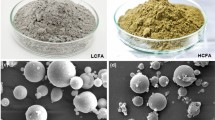Abstract
A by-product (residue) from the Ames Lime-Soda Sinter Process for recovering alumina from power plant fly ash consists largely of dicalcium silicate and can be used as a raw material for the manufacture of sulfate-resistant (Type V) portland cement. Utilization of the residue will eliminate the need for its disposal and will improve the economic feasibility of the lime-soda sinter process. Laboratory burnability tests were used to identify optimum cement mixes and burning temperatures from both clinker quality and economic perspectives. At a typical kiln temperature of 1450°C, cements that formed concrete that exceeded ASTM specifications for strength were obtained for a limited range of lime-saturation factors and silica ratios. A highly conservative cost estimate for a combined alumina recovery and cement manufacturing facility for a 1000 MWe coal-fired power station gave a 4.7% internal rate of return.
Similar content being viewed by others
References
Ash at Work. American Coal Association, Washington, DC, XVI (3), 4 (1984).
J.A. Chesley and G. Burnet, Proc. Conf. on Waste Management for the Energy Industries, Grand Forks, ND, 91 (1987).
J.A. Chesley, unpublished PhD thesis, Iowa State University (1987).
M.J. Murtha and G. Burn, Proc. 5th Intern. Ash Util. Symp., Atlanta, GA, 1979, U.S.D.O.E. METC/SP-79/10, p. 68; Resources and Conversation 9, 301 (1982).
A.A. Tabikh and R.J. Weht, Cem. Concr. Res. I, 317 (1971).
American Society for Testing and Materials (ASTM), Cement, lime, gypsum, and related building materials and systems. The Annual Book of ASTM Standards. Vol. 4,01. (ASTM, Philadelphia, PA 1986).
American Society for Testing and Materials (ASTM), Significance of Tests and Properties of Concrete and Concrete-Making Materials. STP-169B (ASTM, Philadelphia, PA 1981).
J. Katell, Proc. 3rd Kentucky Coal Refuse Disposal and Util. Sem., Lexington, KY (1977).
R.E. Oberholster, J.H.P. Van Aardt, and M.P. Brandt, in Structure and Performance of Cements. P. Barnes ed. (Applied Science Publishers LTD, Essex, England 1983).
F.M. Lea. The Chemistry of Cement and Concrete. 3rd ed. (Chemical Publishing Company, New York, 1971).
Author information
Authors and Affiliations
Rights and permissions
About this article
Cite this article
Chesley, J.A., Burnet, G. Sulfate-Resistant Portland Cement from Lime-Soda Sinter Process Residue. MRS Online Proceedings Library 113, 163–171 (1987). https://doi.org/10.1557/PROC-113-163
Published:
Issue Date:
DOI: https://doi.org/10.1557/PROC-113-163




